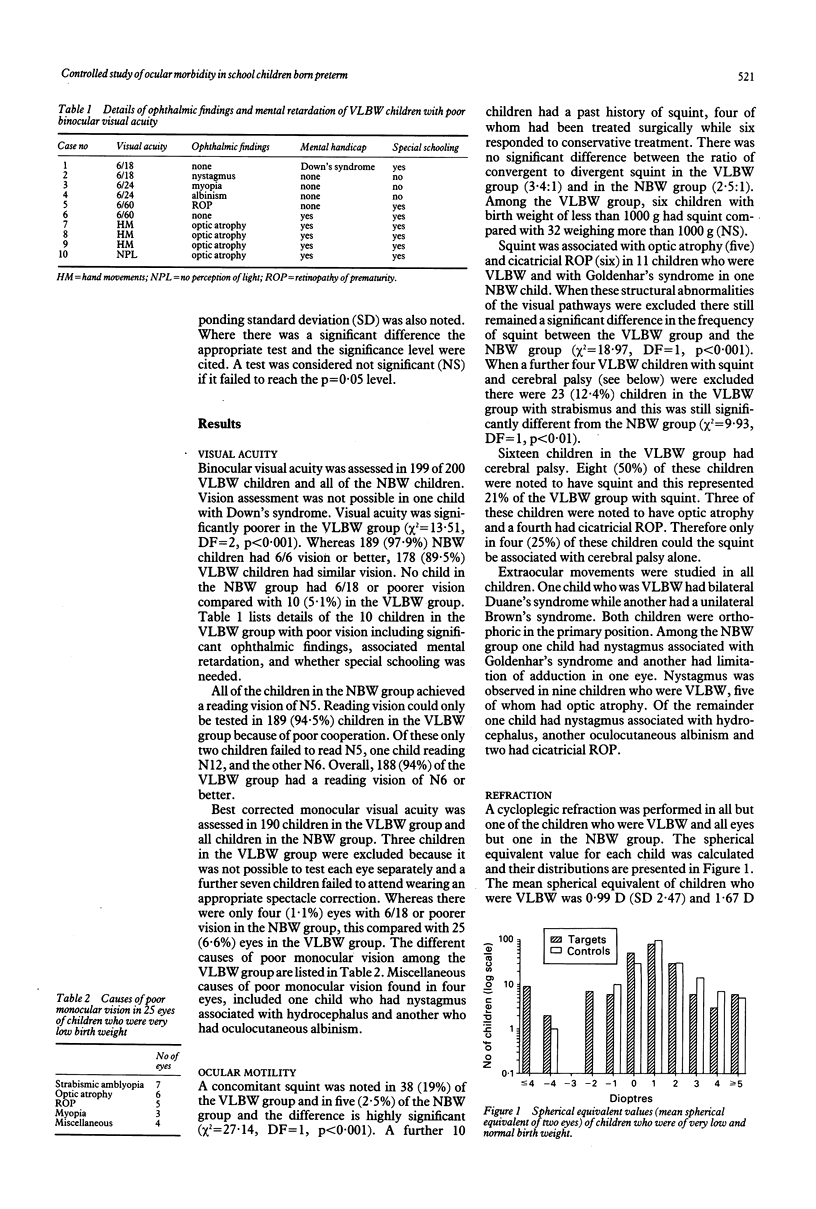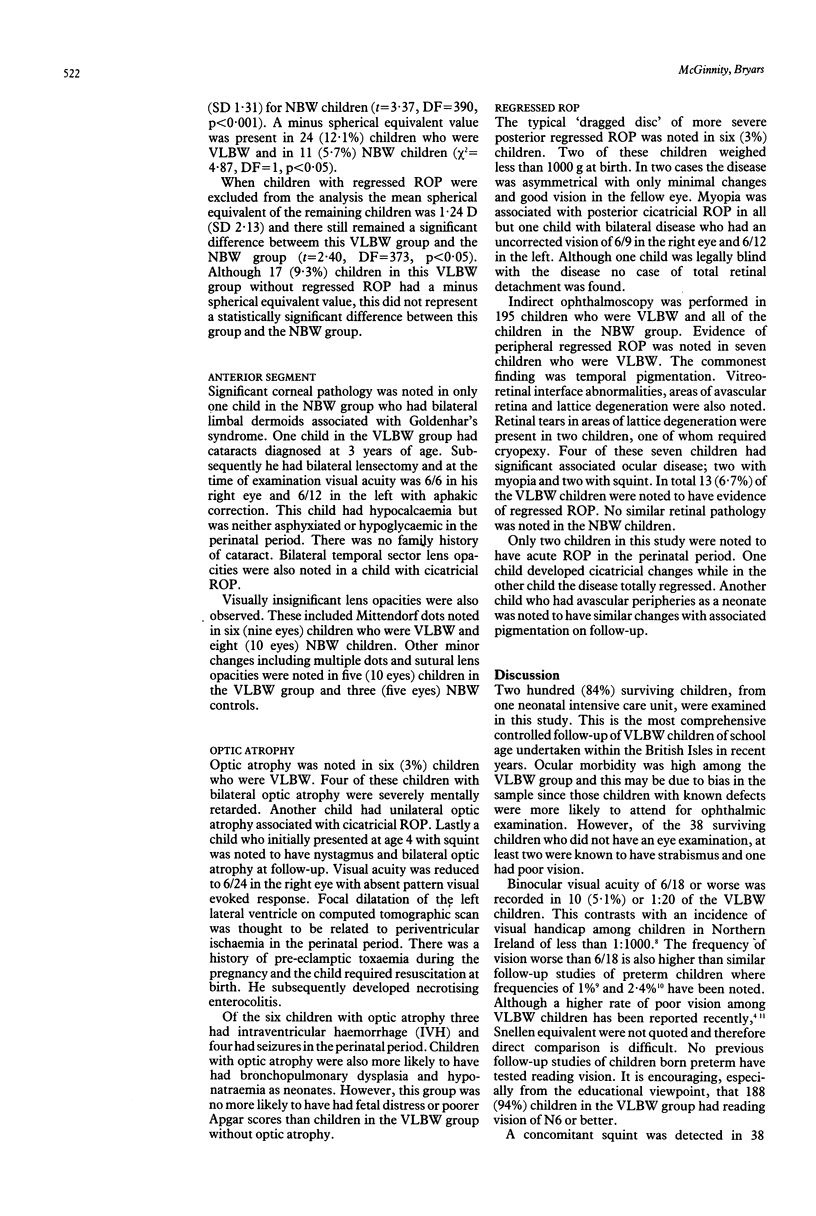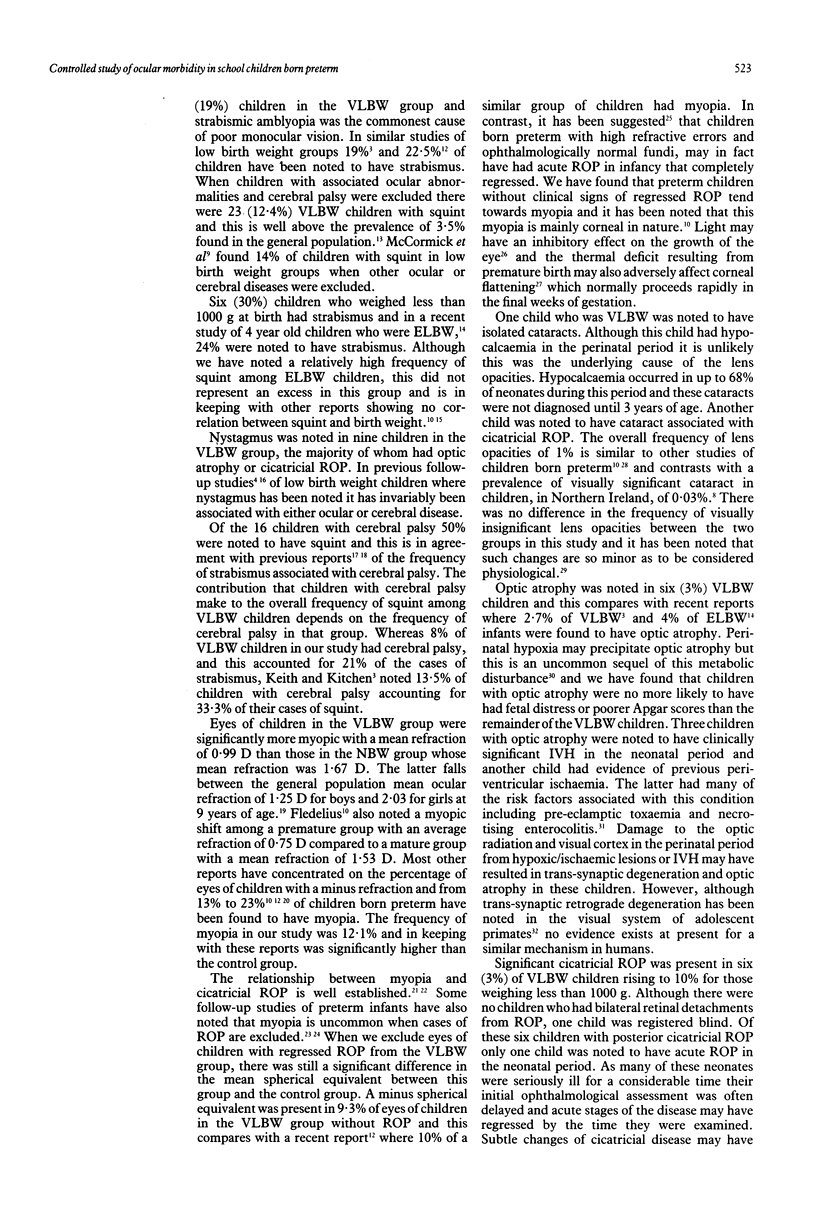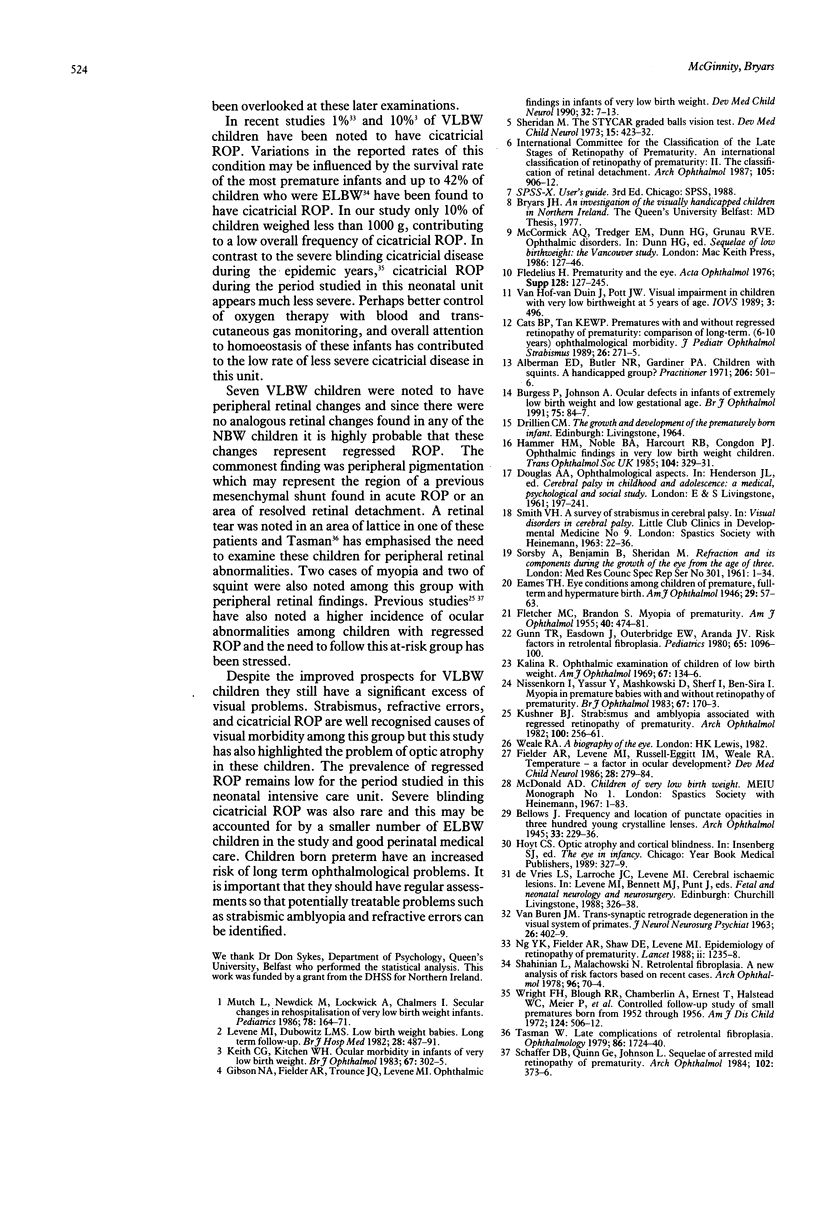Abstract
Two hundred children who were of very low birth weight (VLBW) (1500 g or less) and 193 controls who were of normal birth weight (NBW) were examined at approximately 9 years of age. Binocular visual acuity of 6/6 or better was noted in 178 (89.5%) VLBW children and 189 (97.9%) NBW children. Visual morbidity was significantly higher among VLBW children. Strabismus was present in 38 (19%), cicatricial retinopathy of prematurity in 13 (6.5%), and optic atrophy in six (3%) children in this group. Children who were VLBW were also more myopic than the NBW controls. Optic atrophy was frequently associated with cerebral dysfunction. Regular assessments to identify ocular abnormalities in children who were VLBW are recommended.
Full text
PDF




Selected References
These references are in PubMed. This may not be the complete list of references from this article.
- Alberman E. D., Butler N. R., Gardiner P. A. Children with squints. A handicapped group? Practitioner. 1971 Apr;206(234):501–506. [PubMed] [Google Scholar]
- Cats B. P., Tan K. E. Prematures with and without regressed retinopathy of prematurity: comparison of long-term (6-10 years) ophthalmological morbidity. J Pediatr Ophthalmol Strabismus. 1989 Nov-Dec;26(6):271–275. doi: 10.3928/0191-3913-19891101-05. [DOI] [PubMed] [Google Scholar]
- FLETCHER M. C., BRANDON S. Myopia of prematurity. Am J Ophthalmol. 1955 Oct;40(4):474–481. doi: 10.1016/0002-9394(55)90548-1. [DOI] [PubMed] [Google Scholar]
- Fielder A. R., Levene M. I., Russell-Eggitt I. M., Weale R. A. Temperature--a factor in ocular development? Dev Med Child Neurol. 1986 Jun;28(3):279–284. doi: 10.1111/j.1469-8749.1986.tb03873.x. [DOI] [PubMed] [Google Scholar]
- Fledelius H. Prematurity and the eye. Ophthalmic 10-year follow-up of children of low and normal birth weight. Acta Ophthalmol Suppl. 1976;128:3–245. [PubMed] [Google Scholar]
- Gibson N. A., Fielder A. R., Trounce J. Q., Levene M. I. Ophthalmic findings in infants of very low birthweight. Dev Med Child Neurol. 1990 Jan;32(1):7–13. doi: 10.1111/j.1469-8749.1990.tb08461.x. [DOI] [PubMed] [Google Scholar]
- Gunn T. R., Easdown J., Outerbridge E. W., Aranda J. V. Risk factors in retrolental fibroplasia. Pediatrics. 1980 Jun;65(6):1096–1100. [PubMed] [Google Scholar]
- Hammer H. M., Noble B. A., Harcourt R. B., Congdon P. J. Ophthalmic findings in very low birth weight children. Trans Ophthalmol Soc U K. 1985;104(Pt 3):329–331. [PubMed] [Google Scholar]
- Kalina R. E. Ophthalmic examination of children of low birth weight. Am J Ophthalmol. 1969 Jan;67(1):134–136. doi: 10.1016/0002-9394(69)90018-x. [DOI] [PubMed] [Google Scholar]
- Keith C. G., Kitchen W. H. Ocular morbidity in infants of very low birth weight. Br J Ophthalmol. 1983 May;67(5):302–305. doi: 10.1136/bjo.67.5.302. [DOI] [PMC free article] [PubMed] [Google Scholar]
- Kushner B. J. Strabismus and amblyopia associated with regressed retinopathy of prematurity. Arch Ophthalmol. 1982 Feb;100(2):256–261. doi: 10.1001/archopht.1982.01030030258004. [DOI] [PubMed] [Google Scholar]
- Levene M. I., Dubowitz L. M. Low birth weight babies. Long-term follow-up. Br J Hosp Med. 1982 Nov;28(5):487–492. [PubMed] [Google Scholar]
- Mutch L., Newdick M., Lodwick A., Chalmers I. Secular changes in rehospitalization of very low birth weight infants. Pediatrics. 1986 Jul;78(1):164–171. [PubMed] [Google Scholar]
- Ng Y. K., Fielder A. R., Shaw D. E., Levene M. I. Epidemiology of retinopathy of prematurity. Lancet. 1988 Nov 26;2(8622):1235–1238. doi: 10.1016/s0140-6736(88)90820-3. [DOI] [PubMed] [Google Scholar]
- Nissenkorn I., Yassur Y., Mashkowski D., Sherf I., Ben-Sira I. Myopia in premature babies with and without retinopathy of prematurity. Br J Ophthalmol. 1983 Mar;67(3):170–173. doi: 10.1136/bjo.67.3.170. [DOI] [PMC free article] [PubMed] [Google Scholar]
- Schaffer D. B., Quinn G. E., Johnson L. Sequelae of arrested mild retinopathy of prematurity. Arch Ophthalmol. 1984 Mar;102(3):373–376. doi: 10.1001/archopht.1984.01040030291021. [DOI] [PubMed] [Google Scholar]
- Shahinian L., Jr, Malachowski N. Retrolental fibroplasia: a new analysis of risk factors based on recent cases. Arch Ophthalmol. 1978 Jan;96(1):70–74. doi: 10.1001/archopht.1978.03910050034008. [DOI] [PubMed] [Google Scholar]
- Sheridan M. D. The STYCAR graded-balls vision test. Dev Med Child Neurol. 1973 Aug;15(4):423–432. doi: 10.1111/j.1469-8749.1973.tb05062.x. [DOI] [PubMed] [Google Scholar]
- Tasman W. Late complications of retrolental fibroplasia. Ophthalmology. 1979 Oct;86(10):1724–1740. doi: 10.1016/s0161-6420(79)35346-5. [DOI] [PubMed] [Google Scholar]
- VANBUREN J. M. TRANS-SYNAPTIC RETROGRADE DEGENERATION IN THE VISUAL SYSTEM OF PRIMATES. J Neurol Neurosurg Psychiatry. 1963 Oct;26:402–409. doi: 10.1136/jnnp.26.5.402. [DOI] [PMC free article] [PubMed] [Google Scholar]
- Wright F. H., Blough R. R., Chamberlin A., Ernest T., Halstead W. C., Meier P., Moore R. Y., Naunton R. F., Newell F. W. A controlled follow-up study of small prematures born from 1952 through 1956. Am J Dis Child. 1972 Oct;124(4):506–521. doi: 10.1001/archpedi.1972.02110160044004. [DOI] [PubMed] [Google Scholar]


